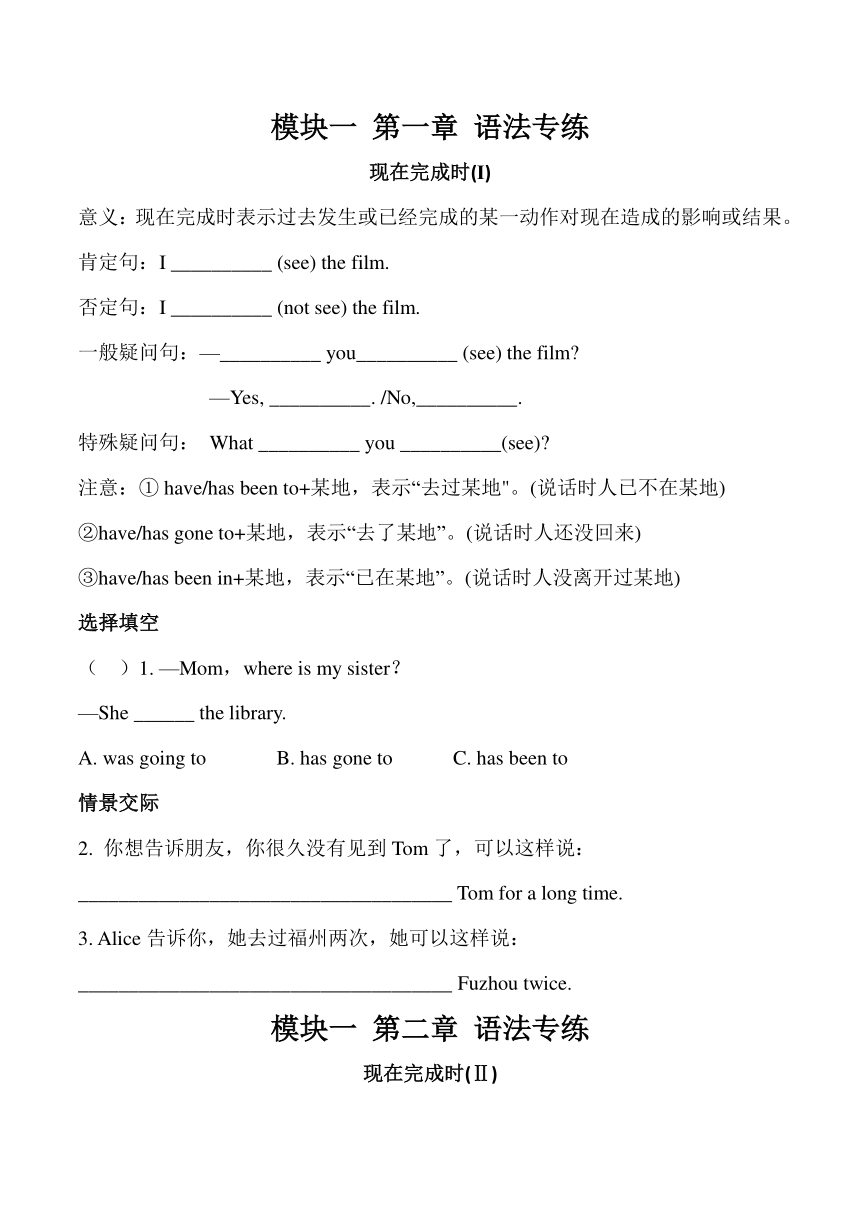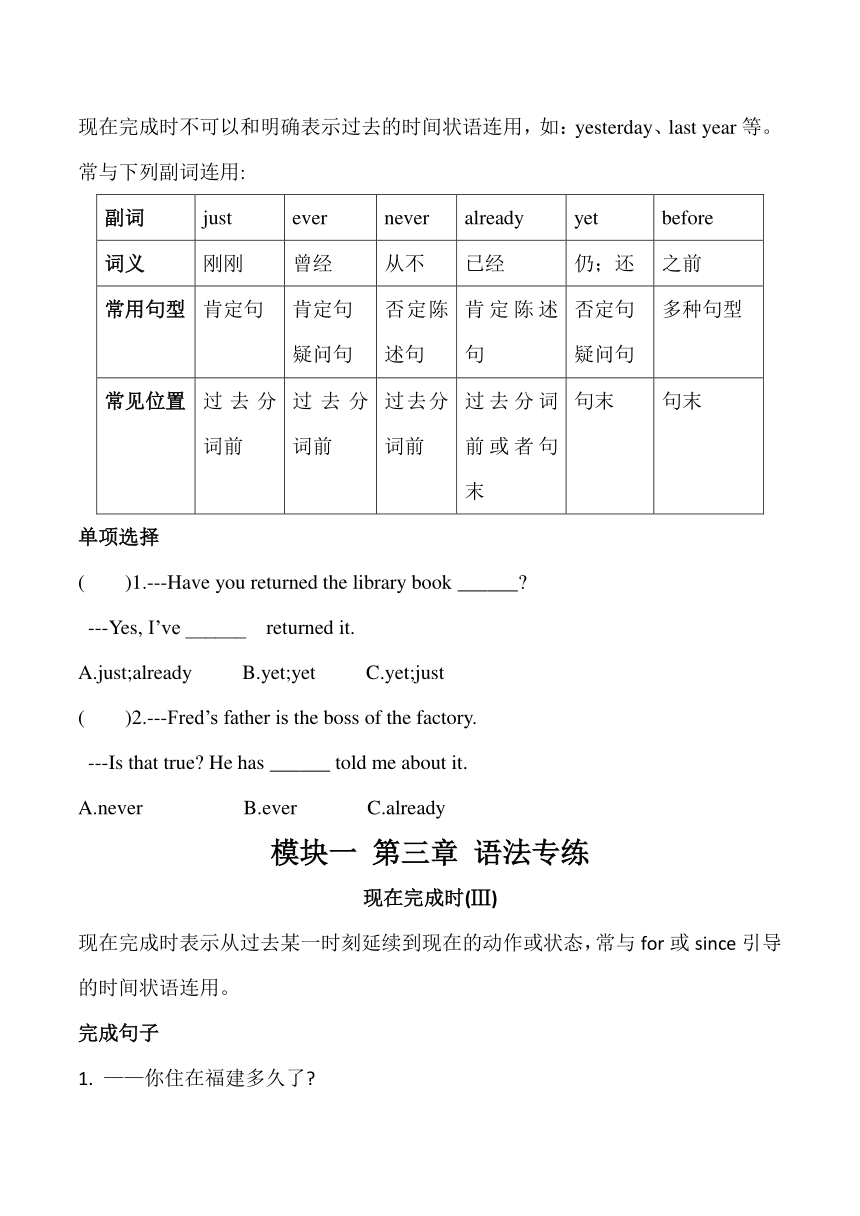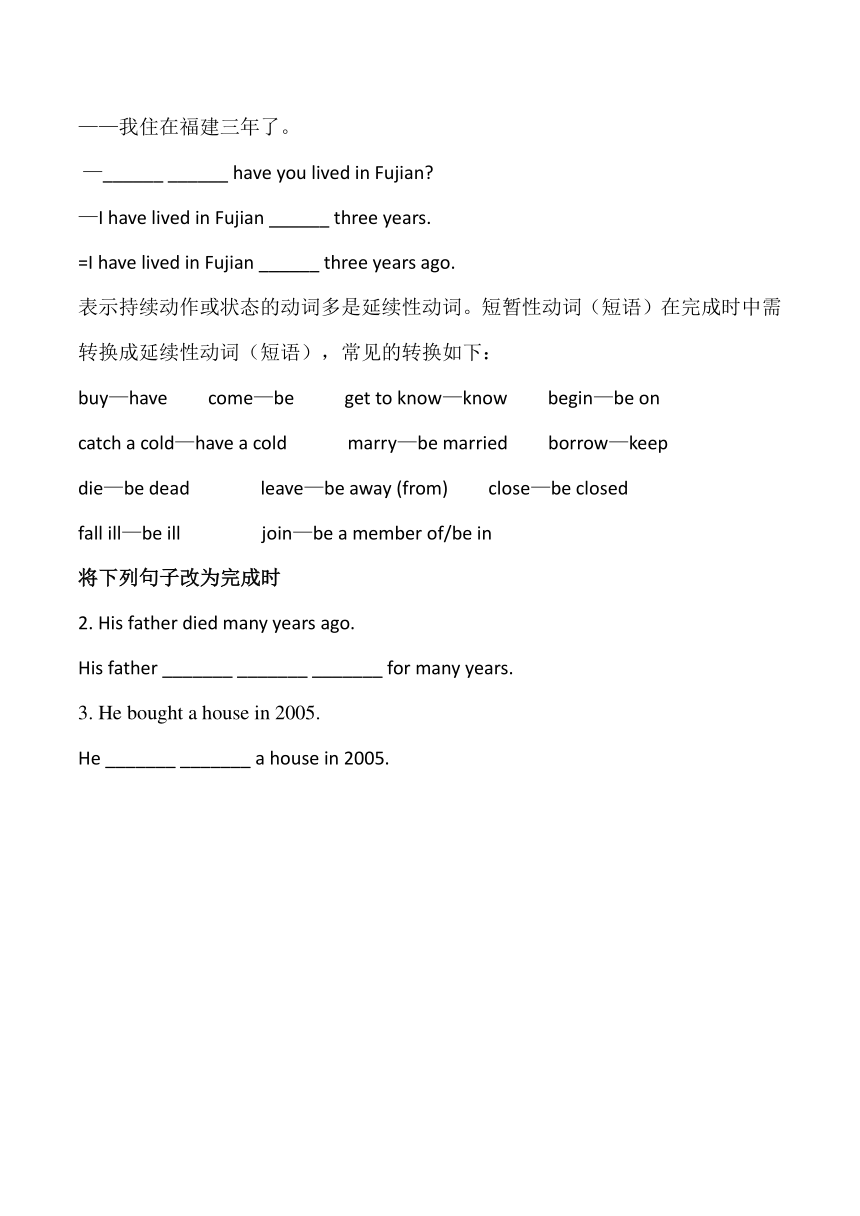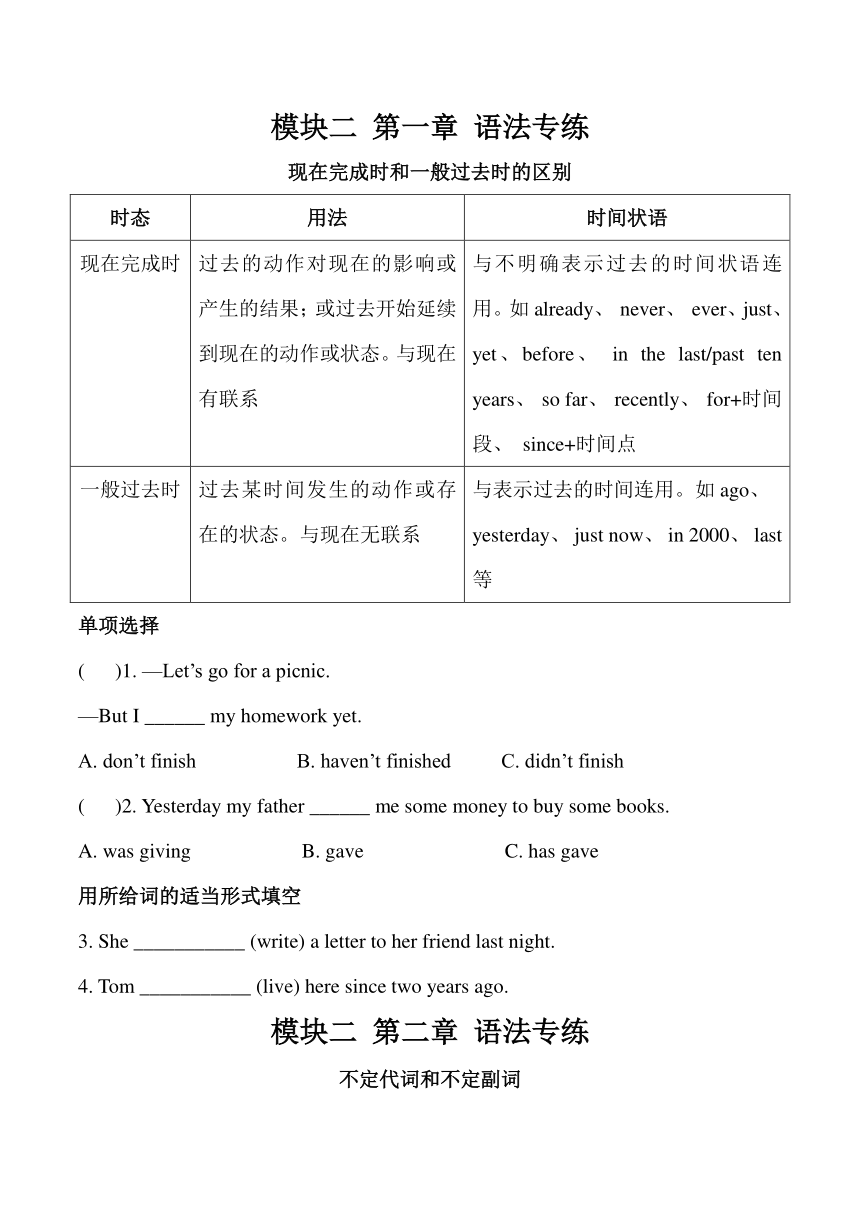仁爱版九年级英语全一册 语法专练(含答案)
文档属性
| 名称 | 仁爱版九年级英语全一册 语法专练(含答案) |  | |
| 格式 | docx | ||
| 文件大小 | 27.7KB | ||
| 资源类型 | 教案 | ||
| 版本资源 | 仁爱科普版 | ||
| 科目 | 英语 | ||
| 更新时间 | 2023-06-29 08:35:38 | ||
图片预览





文档简介
模块一 第一章 语法专练
现在完成时( )
意义:现在完成时表示过去发生或已经完成的某一动作对现在造成的影响或结果。
肯定句:I __________ (see) the film.
否定句:I __________ (not see) the film.
一般疑问句:—__________ you__________ (see) the film
—Yes, __________. /No,__________.
特殊疑问句: What __________ you __________(see)
注意:① have/has been to+某地,表示“去过某地"。(说话时人已不在某地)
②have/has gone to+某地,表示“去了某地”。(说话时人还没回来)
③have/has been in+某地,表示“已在某地”。(说话时人没离开过某地)
选择填空
( )1. —Mom,where is my sister?
—She ______ the library.
A. was going to B. has gone to C. has been to
情景交际
2. 你想告诉朋友,你很久没有见到Tom了,可以这样说:
_____________________________________ Tom for a long time.
3. Alice告诉你,她去过福州两次,她可以这样说:
_____________________________________ Fuzhou twice.
模块一 第二章 语法专练
现在完成时(Ⅱ)
现在完成时不可以和明确表示过去的时间状语连用,如:yesterday、last year等。常与下列副词连用:
副词 just ever never already yet before
词义 刚刚 曾经 从不 已经 仍;还 之前
常用句型 肯定句 肯定句 疑问句 否定陈述句 肯定陈述句 否定句 疑问句 多种句型
常见位置 过去分词前 过去分词前 过去分词前 过去分词前或者句末 句末 句末
单项选择
( )1.---Have you returned the library book ______
---Yes, I’ve ______ returned it.
A.just;already B.yet;yet C.yet;just
( )2.---Fred’s father is the boss of the factory.
---Is that true He has ______ told me about it.
A.never B.ever C.already
模块一 第三章 语法专练
现在完成时(Ⅲ)
现在完成时表示从过去某一时刻延续到现在的动作或状态,常与for或since引导的时间状语连用。
完成句子
1. ——你住在福建多久了
——我住在福建三年了。
—______ ______ have you lived in Fujian
—I have lived in Fujian ______ three years.
=I have lived in Fujian ______ three years ago.
表示持续动作或状态的动词多是延续性动词。短暂性动词(短语)在完成时中需转换成延续性动词(短语),常见的转换如下:
buy—have come—be get to know—know begin—be on
catch a cold—have a cold marry—be married borrow—keep
die—be dead leave—be away (from) close—be closed
fall ill—be ill join—be a member of/be in
将下列句子改为完成时
2. His father died many years ago.
His father _______ _______ _______ for many years.
3. He bought a house in 2005.
He _______ _______ a house in 2005.
模块二 第一章 语法专练
现在完成时和一般过去时的区别
时态 用法 时间状语
现在完成时 过去的动作对现在的影响或产生的结果;或过去开始延续到现在的动作或状态。与现在有联系 与不明确表示过去的时间状语连用。如already、 never、 ever、just、 yet、before、 in the last/past ten years、 so far、 recently、 for+时间段、 since+时间点
一般过去时 过去某时间发生的动作或存在的状态。与现在无联系 与表示过去的时间连用。如ago、 yesterday、 just now、 in 2000、 last等
单项选择
( )1. —Let’s go for a picnic.
—But I ______ my homework yet.
A. don’t finish B. haven’t finished C. didn’t finish
( )2. Yesterday my father ______ me some money to buy some books.
A. was giving B. gave C. has gave
用所给词的适当形式填空
3. She ___________ (write) a letter to her friend last night.
4. Tom ___________ (live) here since two years ago.
模块二 第二章 语法专练
不定代词和不定副词
意义:
不定代词:指不明确代替某些名词或形容词的代词,如 all、each、every、both、either、neither、none、no、one、little、few、 many、 much、other、 another、 some、any 及由 some、any、no、every和 body、one、thing 构成的合成代词。
不定副词:表示不明确指代地方的副词,如 somewhere、anywhere、everywhere。
用法:some-/any-复合代词/副词的用法与some/any的用法基本一致。肯定句以及期待肯定回答的疑问句中通常用前者;否定句和疑问句通常用后者。no-复合代词/副词表完全否定;every-复合代词/副词代替全部。
注意:形容词修饰不定代词时应放在不定代词之后。
单项选择
( )1. I tried many ways, but ______ of them worked.
A. all B. none C. both
( )2.When Tina opened her wallet,she was surprised to find ______. It was empty.
A. nothing B. everything C.something
( )3. —Is there ______ in today’s newspaper
—No, there’s ______.
A. anything special; something unusual
B. anything special; nothing unusual
C. special anything; nothing unusual
用some/any填空
4. He wants to buy ______ apples in the supermarket.
5. Is there ______ tea in the cup
6. Would you like ______ bread
模块二 第三章 语法专练
并列句
并列句是由并列连词把两个或两个以上的简单句连在一起构成的句子,连词前可用逗号,也可不用逗号。
类别 常见连词
并列关系 and, not only... but also..., neither... nor...
转折关系 but, while, yet
选择关系 or, either... or...
因果关系 so,for
单项选择
( )1. I bought my sister a present,______ she didn’t like it.
A. and B. but C. so
( )2. Her mother is ill, ______ she has to stay at home to look after her.
A. and B. but C. so
翻译句子
3. 他的父亲是一位老师,母亲是一位护士。
______________________________________________
4. 快一点,否则你又会错过那班火车。
______________________________________________
模块三 第一章 语法专练
一般现在时的被动语态
意义:被动语态由“be+及物动词的过去分词(+by+宾语)”构成。be有人称、数和时态的变化,其肯定式、否定式、疑问式的变化规则与be作为系动词时一样。
肯定句:Computers __________ (use) in the world.
否定句:Computers __________ (use) in the world.
一般疑问句: —_______ computers __________ (use) in the world
—Yes,________./No, ________.
特殊疑问句:Why _______ computers __________ (use) in the world
注意:主、被动语态互相转换时,时态不变;若主动句的主语是代词的主格形式,变成被动语态by的宾语时,要用宾格形式。
单项选择
( )1.—What a nice classroom!
—It _____ every day.
A.is cleaning B.has cleaned C. is cleaned
( )2.—What is a writing brush used for
—It’s used _____ writing and drawing.
A.for B.to C.by
将下列句子改写成被动语态,每空不限词数
3. My teacher always asks me to finish homework.
I ______________________to finish homework__________________.
4. She takes care of the kids.
The kids ______________________.
模块三 第二章 语法专练
现在进行时表示将来
意义:现在进行时表示将来时,常有“意图”“安排”或“打算”之意。其所涉动词多是位移动词,如 come、go、arrive、leave、fly、return 等。某些非位移动词也可用现在进行时表示将来,如 sleep、take、change、get、meet 等。
单项选择
( )1. It ______ dark. Shall I turn on the light
A. is getting B. gets C. got
( )2. —My father and I ______ Shanghai tomorrow.
—Have a good trip!
A. am leaving for B. leave for C. are leaving for
用现在进行时表示将来,每空不限词数
3. The train ____________ (arrive) here soon.
4. My friends ____________ (come) to have supper.
5. My uncle ____________ (meet) us tomorrow.
模块三 第三章 语法专练
疑问词+ to do
疑问词有 when、where、which、who(m)、what、how及 whether 等。“疑问词+to do结构”在句中常作_______、_______和宾语,做宾语时可以转换为宾语从句。
注意:如果主句的主语与宾语从句的主语一致,宾语从句通常可以与“疑问词+to do结构”互相转换;如果主语不一致,则不能转换。若 “疑问词+to do结构”中的动作尚未发生,在转换成宾语从句时,通常要加情态动词或用一般将来时。
单项选择
( )1. —This math problem is too difficult. Can you show me ______, Tom
—Of course.
A. how to work it out B. when to work it out C. what to work it out
按要求完成下列句子
2. I don’t know what I should do with the broken bike.(改为同义句)
I don’t know what _______ _______ _______ the broken bike.
3. Michael doesn’t know where he should stick the map.(改为同义句)
Michael doesn’t know_______ _______ _______ the map.
4.我会给你展示如何使用这台机器。
I’ll show you _______ _______ _______ the machine.
5.他无法决定是否要加入英语俱乐部。
He can't decide _______ _______ _______ the English club.
模块四 第一章 语法专练
一般过去时的被动语态
was/were+动词过去分词(+by+宾语)
注意:其用法与一般现在时的被动语态一样。
肯定句:It __________ (make) in Shanghai in 2002.
否定句:It __________ (make) in Shanghai in 2002.
一般疑问句: —_______ it __________(make) in Shanghai in 2002
—Yes,________./No, ________.
特殊疑问句: Where __________ it __________ (make) in 2002
单项选择
( )1. The mobile phone has influenced people’s life a lot since it ________.
A. invented B. invents C. is invented
情景交际
2. 妹妹想知道灯泡的发明时间,她可以这样问你:
When __________________________________
按要求完成下列句子
3. The people saved the girl from the sea.(改为被动语态)
The girl ________ ________ from the sea by the people.
4. My uncle repaired the computer yesterday. (改为被动语态)
The computer ________ ________ by my uncle yesterday.
5. The big plane was invented in China last year. (对画线部分提问)
________ ________ the big plane ________ last year?
模块四 第二章 语法专练
一般将来时的被动语态
will be +及物动词的过去分词
肯定句:My work __________(finish) in thirty minutes.
否定句:My work __________(finish) in thirty minutes.
一般疑问句: —_______ your work _______ (finish) in thirty minutes
—Yes,________./No, ________.
特殊疑问句:When _______ your work __________(finish)
单项选择
( )1. The sport meet _______ in our school next week.
A. hold B. will hold C. will be held
用所给单词的适当形式填空
2. You _______ (punish) if you break the rules.
3. Your goal _______ (not realize) if you don't work hard.
4. _______ a famous painting _______ (display) in the coming art show
5.What time _______ the movie _______ (put) on tomorrow
模块四 第三章 语法专练
定语从句( )
意义:在复合句中,修饰某一名词或代词充当定语的从句叫定语从句。被修饰的名词或代词叫先行词,定语从句一般放在先行词的后面。
定语从句的关系词:
关系代词包括that、which、who(宾格whom,所有格whose)等,关系副词包括 where、when、why等。
that、which、who在定语从句中作主语的用法:
关系代词 成分 能否省略 先行词
that 主语 否 人/物
which 主语 否 物
who 主语 否 人
注意:先行词中既有人又有物时,关系词用that。
单项选择
( )1. That is a dictionary ______ helps me a lot.
A. who B. that C. whose
( )2. —Do you know her
—Yes. She is an ordinary worker ______ helps many people in need.
A. who B. whom C. which
用 who/which/that 填空
3. Do you know the girl ______ is from Beijing?
4. I want to read the books ______ were written by a famous writer.
5. I will never forget the people and things ______ appear in my life.
模块五 第一章 语法专练
定语从句(Ⅱ)
定语从句的分类:
根据定语从句与先行词的关系,定语从句可分为限制性定语从句和非限制性定语从句。限制性定语从句:从句紧跟先行词,主句和从句不用逗号隔开,从句不可省略;非限制性定语从句:主句和从句之间有逗号隔开,从句起补充说明的作用,如省去,主句意思仍完整。
that、which在定语从句中作宾语的用法
关系代词 成分 能否省略 先行词
that 宾语 能 人/物
which 宾语 能 物
注意:定语从句中含有介词,且介词放在句末时,that、which可以省略;介词在关系代词前时,只能用“介词+which”的结构。
单项选择
( )1. Have you ever been to Hangzhou, _____is famous for the West Lake
A. that B. who C. which
( )2.The coat _____ I put on the desk is blue.
A. that B. who C. when
( )3. This is the house in _____ we lived last year.
A. that B. who C. which
关系副词在定语从句中的用法
关系副词 先行词 成分
when 表示时间 时间状语
where 表示地点 地点状语
why 表示原因 原因状语
用 when/where/why 填空
4. This was the time ______ he arrived.
5. This is the place ______ he works.
6. Nobody knows the reason ______ he is often late for school.
模块五 第二章 语法专练
定语从句(Ⅲ)
who、whom、whose在定语从句中的用法
关系代词 成分 能否省略 先行词
who 主语、宾语 做主语不能省略 作宾语能省略 人
whom 宾语 作介词宾语不能省略 人
whose 定语 否 人/物
注意:whose指物时,可用of which代替
单项选择
( )1. The young man ______ skirt is white is our English teacher Miss Yang.
A. who B. whose C. whom
( )2. Who is the teacher ______ Li Ming is talking to?
A. who B. whose C. whom
模块五 第三章 语法专练
并列连词
意义:并列连词是用来连接并列成分或句子的连词。并列连词主要表示并列关系、选择关系、转折关系、因果关系等。
关系 连词 词义 谓语形式
并列关系 both...and... 两者都 复数
not only...but also... 不但……而且 就近原则(与最靠近的主语的数一致)
neither... nor 既不……也不
选择关系 either...or... 或者……或者, 要么……要么
not...but... 不是……而是
单项选择
( )1. Both Mike and His sister Lucy ______ good at Chinese.
A. is B. am C. are
按要求完成句子
2. I don't like the blue sweater. I don’t like the red sweater, either.(合为一句话)
I like ______ the blue sweater ______ the red sweater.
3. 不是我们而是她迟到了。
______we ______ she _____ _______.
参考答案
模块一 第一章 语法专练
have seen;haven’t seen;Have;seen;I have;I haven’t;have;seen
1. B
2. I haven't seen Tom for a long time.
3. I have been to Fuzhou twice.
模块一 第二章 语法专练
1. C
2. A
模块一 第三章 语法专练
1. How long;for;since
2. has been dead
3. has had
模块二 第一章 语法专练
1. B
2. B
3. wrote
4. has lived
模块二 第二章 语法专练
1. B
2. A
3.B
4. some
5. any
6. some
模块二 第三章 语法专练
1. B
2. C
3. His father is a teacher and his mother is a nurse.
4. Hurry up, or you will miss that train again.
模块三 第一章 语法专练
are used;aren't used; Are; used; they are; they aren’t; are; used
1. C
2. A
3. am always asked; by my teacher
4. are taken care of by her
模块三 第二章 语法专练
1. A
2. C
3. is arriving
4. are coming
5. is meeting
模块三 第三章 语法专练
主语;表语
1. A
2. to do with
3. where to stick
4. how to use
5. whether to join
模块四 第一章 语法专练
was made; wasn’t made; Is; made; it was; it wasn’t; is; made
1. C
2. When was the light bulb invented
3. was saved
4. was repaired
5. Where was; invented
模块四 第二章 语法专练
will be finished;will not/won’t be finished;Will;be finished;it will; it won’t;will;be finished
1. C
2. will be punished
3. won't be realized
4. Will; be displayed
5. will;be put
模块四 第三章 语法专练
1. B
2. A
3. that/who
4. that/which
5. that
模块五 第一章 语法专练
1. C
2. A
3. C
4. when
5. where
6. why
模块五 第二章 语法专练
1. B
2.C
模块五 第三章 语法专练
1. C
2. neither;nor
3. Not; but; was late
现在完成时( )
意义:现在完成时表示过去发生或已经完成的某一动作对现在造成的影响或结果。
肯定句:I __________ (see) the film.
否定句:I __________ (not see) the film.
一般疑问句:—__________ you__________ (see) the film
—Yes, __________. /No,__________.
特殊疑问句: What __________ you __________(see)
注意:① have/has been to+某地,表示“去过某地"。(说话时人已不在某地)
②have/has gone to+某地,表示“去了某地”。(说话时人还没回来)
③have/has been in+某地,表示“已在某地”。(说话时人没离开过某地)
选择填空
( )1. —Mom,where is my sister?
—She ______ the library.
A. was going to B. has gone to C. has been to
情景交际
2. 你想告诉朋友,你很久没有见到Tom了,可以这样说:
_____________________________________ Tom for a long time.
3. Alice告诉你,她去过福州两次,她可以这样说:
_____________________________________ Fuzhou twice.
模块一 第二章 语法专练
现在完成时(Ⅱ)
现在完成时不可以和明确表示过去的时间状语连用,如:yesterday、last year等。常与下列副词连用:
副词 just ever never already yet before
词义 刚刚 曾经 从不 已经 仍;还 之前
常用句型 肯定句 肯定句 疑问句 否定陈述句 肯定陈述句 否定句 疑问句 多种句型
常见位置 过去分词前 过去分词前 过去分词前 过去分词前或者句末 句末 句末
单项选择
( )1.---Have you returned the library book ______
---Yes, I’ve ______ returned it.
A.just;already B.yet;yet C.yet;just
( )2.---Fred’s father is the boss of the factory.
---Is that true He has ______ told me about it.
A.never B.ever C.already
模块一 第三章 语法专练
现在完成时(Ⅲ)
现在完成时表示从过去某一时刻延续到现在的动作或状态,常与for或since引导的时间状语连用。
完成句子
1. ——你住在福建多久了
——我住在福建三年了。
—______ ______ have you lived in Fujian
—I have lived in Fujian ______ three years.
=I have lived in Fujian ______ three years ago.
表示持续动作或状态的动词多是延续性动词。短暂性动词(短语)在完成时中需转换成延续性动词(短语),常见的转换如下:
buy—have come—be get to know—know begin—be on
catch a cold—have a cold marry—be married borrow—keep
die—be dead leave—be away (from) close—be closed
fall ill—be ill join—be a member of/be in
将下列句子改为完成时
2. His father died many years ago.
His father _______ _______ _______ for many years.
3. He bought a house in 2005.
He _______ _______ a house in 2005.
模块二 第一章 语法专练
现在完成时和一般过去时的区别
时态 用法 时间状语
现在完成时 过去的动作对现在的影响或产生的结果;或过去开始延续到现在的动作或状态。与现在有联系 与不明确表示过去的时间状语连用。如already、 never、 ever、just、 yet、before、 in the last/past ten years、 so far、 recently、 for+时间段、 since+时间点
一般过去时 过去某时间发生的动作或存在的状态。与现在无联系 与表示过去的时间连用。如ago、 yesterday、 just now、 in 2000、 last等
单项选择
( )1. —Let’s go for a picnic.
—But I ______ my homework yet.
A. don’t finish B. haven’t finished C. didn’t finish
( )2. Yesterday my father ______ me some money to buy some books.
A. was giving B. gave C. has gave
用所给词的适当形式填空
3. She ___________ (write) a letter to her friend last night.
4. Tom ___________ (live) here since two years ago.
模块二 第二章 语法专练
不定代词和不定副词
意义:
不定代词:指不明确代替某些名词或形容词的代词,如 all、each、every、both、either、neither、none、no、one、little、few、 many、 much、other、 another、 some、any 及由 some、any、no、every和 body、one、thing 构成的合成代词。
不定副词:表示不明确指代地方的副词,如 somewhere、anywhere、everywhere。
用法:some-/any-复合代词/副词的用法与some/any的用法基本一致。肯定句以及期待肯定回答的疑问句中通常用前者;否定句和疑问句通常用后者。no-复合代词/副词表完全否定;every-复合代词/副词代替全部。
注意:形容词修饰不定代词时应放在不定代词之后。
单项选择
( )1. I tried many ways, but ______ of them worked.
A. all B. none C. both
( )2.When Tina opened her wallet,she was surprised to find ______. It was empty.
A. nothing B. everything C.something
( )3. —Is there ______ in today’s newspaper
—No, there’s ______.
A. anything special; something unusual
B. anything special; nothing unusual
C. special anything; nothing unusual
用some/any填空
4. He wants to buy ______ apples in the supermarket.
5. Is there ______ tea in the cup
6. Would you like ______ bread
模块二 第三章 语法专练
并列句
并列句是由并列连词把两个或两个以上的简单句连在一起构成的句子,连词前可用逗号,也可不用逗号。
类别 常见连词
并列关系 and, not only... but also..., neither... nor...
转折关系 but, while, yet
选择关系 or, either... or...
因果关系 so,for
单项选择
( )1. I bought my sister a present,______ she didn’t like it.
A. and B. but C. so
( )2. Her mother is ill, ______ she has to stay at home to look after her.
A. and B. but C. so
翻译句子
3. 他的父亲是一位老师,母亲是一位护士。
______________________________________________
4. 快一点,否则你又会错过那班火车。
______________________________________________
模块三 第一章 语法专练
一般现在时的被动语态
意义:被动语态由“be+及物动词的过去分词(+by+宾语)”构成。be有人称、数和时态的变化,其肯定式、否定式、疑问式的变化规则与be作为系动词时一样。
肯定句:Computers __________ (use) in the world.
否定句:Computers __________ (use) in the world.
一般疑问句: —_______ computers __________ (use) in the world
—Yes,________./No, ________.
特殊疑问句:Why _______ computers __________ (use) in the world
注意:主、被动语态互相转换时,时态不变;若主动句的主语是代词的主格形式,变成被动语态by的宾语时,要用宾格形式。
单项选择
( )1.—What a nice classroom!
—It _____ every day.
A.is cleaning B.has cleaned C. is cleaned
( )2.—What is a writing brush used for
—It’s used _____ writing and drawing.
A.for B.to C.by
将下列句子改写成被动语态,每空不限词数
3. My teacher always asks me to finish homework.
I ______________________to finish homework__________________.
4. She takes care of the kids.
The kids ______________________.
模块三 第二章 语法专练
现在进行时表示将来
意义:现在进行时表示将来时,常有“意图”“安排”或“打算”之意。其所涉动词多是位移动词,如 come、go、arrive、leave、fly、return 等。某些非位移动词也可用现在进行时表示将来,如 sleep、take、change、get、meet 等。
单项选择
( )1. It ______ dark. Shall I turn on the light
A. is getting B. gets C. got
( )2. —My father and I ______ Shanghai tomorrow.
—Have a good trip!
A. am leaving for B. leave for C. are leaving for
用现在进行时表示将来,每空不限词数
3. The train ____________ (arrive) here soon.
4. My friends ____________ (come) to have supper.
5. My uncle ____________ (meet) us tomorrow.
模块三 第三章 语法专练
疑问词+ to do
疑问词有 when、where、which、who(m)、what、how及 whether 等。“疑问词+to do结构”在句中常作_______、_______和宾语,做宾语时可以转换为宾语从句。
注意:如果主句的主语与宾语从句的主语一致,宾语从句通常可以与“疑问词+to do结构”互相转换;如果主语不一致,则不能转换。若 “疑问词+to do结构”中的动作尚未发生,在转换成宾语从句时,通常要加情态动词或用一般将来时。
单项选择
( )1. —This math problem is too difficult. Can you show me ______, Tom
—Of course.
A. how to work it out B. when to work it out C. what to work it out
按要求完成下列句子
2. I don’t know what I should do with the broken bike.(改为同义句)
I don’t know what _______ _______ _______ the broken bike.
3. Michael doesn’t know where he should stick the map.(改为同义句)
Michael doesn’t know_______ _______ _______ the map.
4.我会给你展示如何使用这台机器。
I’ll show you _______ _______ _______ the machine.
5.他无法决定是否要加入英语俱乐部。
He can't decide _______ _______ _______ the English club.
模块四 第一章 语法专练
一般过去时的被动语态
was/were+动词过去分词(+by+宾语)
注意:其用法与一般现在时的被动语态一样。
肯定句:It __________ (make) in Shanghai in 2002.
否定句:It __________ (make) in Shanghai in 2002.
一般疑问句: —_______ it __________(make) in Shanghai in 2002
—Yes,________./No, ________.
特殊疑问句: Where __________ it __________ (make) in 2002
单项选择
( )1. The mobile phone has influenced people’s life a lot since it ________.
A. invented B. invents C. is invented
情景交际
2. 妹妹想知道灯泡的发明时间,她可以这样问你:
When __________________________________
按要求完成下列句子
3. The people saved the girl from the sea.(改为被动语态)
The girl ________ ________ from the sea by the people.
4. My uncle repaired the computer yesterday. (改为被动语态)
The computer ________ ________ by my uncle yesterday.
5. The big plane was invented in China last year. (对画线部分提问)
________ ________ the big plane ________ last year?
模块四 第二章 语法专练
一般将来时的被动语态
will be +及物动词的过去分词
肯定句:My work __________(finish) in thirty minutes.
否定句:My work __________(finish) in thirty minutes.
一般疑问句: —_______ your work _______ (finish) in thirty minutes
—Yes,________./No, ________.
特殊疑问句:When _______ your work __________(finish)
单项选择
( )1. The sport meet _______ in our school next week.
A. hold B. will hold C. will be held
用所给单词的适当形式填空
2. You _______ (punish) if you break the rules.
3. Your goal _______ (not realize) if you don't work hard.
4. _______ a famous painting _______ (display) in the coming art show
5.What time _______ the movie _______ (put) on tomorrow
模块四 第三章 语法专练
定语从句( )
意义:在复合句中,修饰某一名词或代词充当定语的从句叫定语从句。被修饰的名词或代词叫先行词,定语从句一般放在先行词的后面。
定语从句的关系词:
关系代词包括that、which、who(宾格whom,所有格whose)等,关系副词包括 where、when、why等。
that、which、who在定语从句中作主语的用法:
关系代词 成分 能否省略 先行词
that 主语 否 人/物
which 主语 否 物
who 主语 否 人
注意:先行词中既有人又有物时,关系词用that。
单项选择
( )1. That is a dictionary ______ helps me a lot.
A. who B. that C. whose
( )2. —Do you know her
—Yes. She is an ordinary worker ______ helps many people in need.
A. who B. whom C. which
用 who/which/that 填空
3. Do you know the girl ______ is from Beijing?
4. I want to read the books ______ were written by a famous writer.
5. I will never forget the people and things ______ appear in my life.
模块五 第一章 语法专练
定语从句(Ⅱ)
定语从句的分类:
根据定语从句与先行词的关系,定语从句可分为限制性定语从句和非限制性定语从句。限制性定语从句:从句紧跟先行词,主句和从句不用逗号隔开,从句不可省略;非限制性定语从句:主句和从句之间有逗号隔开,从句起补充说明的作用,如省去,主句意思仍完整。
that、which在定语从句中作宾语的用法
关系代词 成分 能否省略 先行词
that 宾语 能 人/物
which 宾语 能 物
注意:定语从句中含有介词,且介词放在句末时,that、which可以省略;介词在关系代词前时,只能用“介词+which”的结构。
单项选择
( )1. Have you ever been to Hangzhou, _____is famous for the West Lake
A. that B. who C. which
( )2.The coat _____ I put on the desk is blue.
A. that B. who C. when
( )3. This is the house in _____ we lived last year.
A. that B. who C. which
关系副词在定语从句中的用法
关系副词 先行词 成分
when 表示时间 时间状语
where 表示地点 地点状语
why 表示原因 原因状语
用 when/where/why 填空
4. This was the time ______ he arrived.
5. This is the place ______ he works.
6. Nobody knows the reason ______ he is often late for school.
模块五 第二章 语法专练
定语从句(Ⅲ)
who、whom、whose在定语从句中的用法
关系代词 成分 能否省略 先行词
who 主语、宾语 做主语不能省略 作宾语能省略 人
whom 宾语 作介词宾语不能省略 人
whose 定语 否 人/物
注意:whose指物时,可用of which代替
单项选择
( )1. The young man ______ skirt is white is our English teacher Miss Yang.
A. who B. whose C. whom
( )2. Who is the teacher ______ Li Ming is talking to?
A. who B. whose C. whom
模块五 第三章 语法专练
并列连词
意义:并列连词是用来连接并列成分或句子的连词。并列连词主要表示并列关系、选择关系、转折关系、因果关系等。
关系 连词 词义 谓语形式
并列关系 both...and... 两者都 复数
not only...but also... 不但……而且 就近原则(与最靠近的主语的数一致)
neither... nor 既不……也不
选择关系 either...or... 或者……或者, 要么……要么
not...but... 不是……而是
单项选择
( )1. Both Mike and His sister Lucy ______ good at Chinese.
A. is B. am C. are
按要求完成句子
2. I don't like the blue sweater. I don’t like the red sweater, either.(合为一句话)
I like ______ the blue sweater ______ the red sweater.
3. 不是我们而是她迟到了。
______we ______ she _____ _______.
参考答案
模块一 第一章 语法专练
have seen;haven’t seen;Have;seen;I have;I haven’t;have;seen
1. B
2. I haven't seen Tom for a long time.
3. I have been to Fuzhou twice.
模块一 第二章 语法专练
1. C
2. A
模块一 第三章 语法专练
1. How long;for;since
2. has been dead
3. has had
模块二 第一章 语法专练
1. B
2. B
3. wrote
4. has lived
模块二 第二章 语法专练
1. B
2. A
3.B
4. some
5. any
6. some
模块二 第三章 语法专练
1. B
2. C
3. His father is a teacher and his mother is a nurse.
4. Hurry up, or you will miss that train again.
模块三 第一章 语法专练
are used;aren't used; Are; used; they are; they aren’t; are; used
1. C
2. A
3. am always asked; by my teacher
4. are taken care of by her
模块三 第二章 语法专练
1. A
2. C
3. is arriving
4. are coming
5. is meeting
模块三 第三章 语法专练
主语;表语
1. A
2. to do with
3. where to stick
4. how to use
5. whether to join
模块四 第一章 语法专练
was made; wasn’t made; Is; made; it was; it wasn’t; is; made
1. C
2. When was the light bulb invented
3. was saved
4. was repaired
5. Where was; invented
模块四 第二章 语法专练
will be finished;will not/won’t be finished;Will;be finished;it will; it won’t;will;be finished
1. C
2. will be punished
3. won't be realized
4. Will; be displayed
5. will;be put
模块四 第三章 语法专练
1. B
2. A
3. that/who
4. that/which
5. that
模块五 第一章 语法专练
1. C
2. A
3. C
4. when
5. where
6. why
模块五 第二章 语法专练
1. B
2.C
模块五 第三章 语法专练
1. C
2. neither;nor
3. Not; but; was late
同课章节目录
- Unit 5 China and the world
- Topic 1 China attracts millions of tourists from a
- Topic 2 He is really the pride of China.
- Topic 3 Now it is a symbol of England.
- Unit 6 Entertainment and Friendship.
- Topic 1 I would rather watch sports shows than tho
- Topic 2 Who is your favorite character in literatu
- Topic 3 I will remember our friendship forever.
